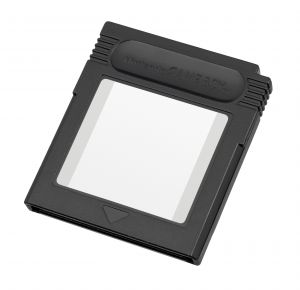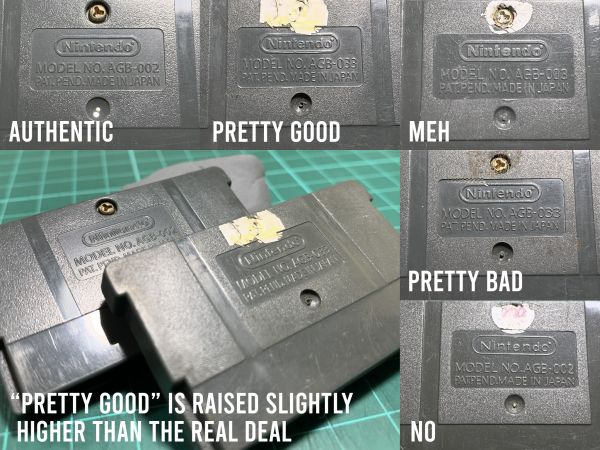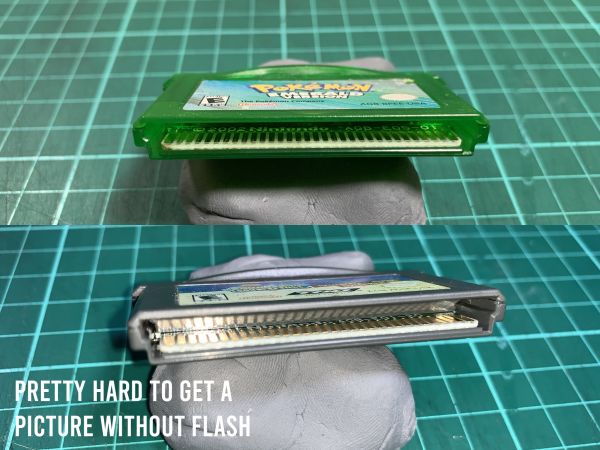Identifying Fake Carts
(Redirected from Identifying Fake Carts)
Jump to navigation
Jump to search
This guide has been adapted from a post originally made by /u/SeanOrtiz on the r/Gameboy Subreddit.
Game Boy Games
This section refers to original Game Boy (DMG) games.
Label
- Label art generally is not the same as the box art. It should be relatively easy to find the original game art online.
- The label should have a factory imprint on it like two numbers or a number and a letter. They can fade over time though and labels can easily be replaced.

- Some Game Boy games will also have grey borders on the left and right sides with the game's serial code and region written on them. This is not always the case.
- The ESRB Rating of "E for everyone" logo varies. ESRB revised logos within this generation of games, so earlier games should have the old logo and later games should have the current logo. A popular example of games that changed ESRB logos in between prints is Pokémon Red, Blue, and Yellow.
- If the label looks like it was printed from a home printer, it's likely fake.
- Check the code printed on the label to see if it matches the game.

Cart
- If it doesn't say "Nintendo GAME BOY™" at the top, it's a guaranteed bootleg.
- The Nintendo logo has never changed fonts since the 70's. Nintendo's logo is supposed to be thick vertically while thin horizontally, but it's not always apparent.
- If the font looks like it's consistent in thickness, if the "t" looks like it has a tail like a "j", or if anything looks off even with just a single letter — that's a red flag.
- Do note that the "e" can look slightly different, even on authentic games.
- The "GAME BOY" part should be thinner than the Nintendo logo. It should also be somewhat italicized. It should look more like GAME BOY than "GAME BOY".
- The trademark symbol
™should be the smallest and the thinnest. - All of these should be all aligned at the bottom. If one is raised higher than than the others, that's a red flag.
- The Nintendo logo has never changed fonts since the 70's. Nintendo's logo is supposed to be thick vertically while thin horizontally, but it's not always apparent.
- Other moldings include the down arrow which is often too deep on most bootlegs.

Items of Note
- This was an era when Nintendo used to off-load some manufacturing to others.
- There have been some cases of verified authentic carts with the Nintendo logo on the grip isn't necessarily 1:1 with Nintendo's actual logo. "Alleyway" is one such game with variants that don't match the normal logo.
- While it's often an indicator of a fake cart, some early Game Boy games have black blobs over their chips. Tetris is one such example.
GBC Games
This section refers to Game Boy Color games.
Label
- Label art generally is not the same as the box art. It should be relatively easy to find the original game art online.
- The label should have a factory imprint on it like two numbers or a number and a letter. They can fade over time though and labels can easily be replaced.
- If the label looks like it was printed from a home printer, it's likely fake.
Cart
- With some exceptions, there are two type GBC games:
- GBC games with black (or yellow) cases show that they are backwards compatible with the original Game Boy.
- GBC games with translucent grey carts with "GAME BOY COLOR" branding at the top.
- GBC games with translucent cases are guaranteed to be the real deal. No bootlegs have ever replicated these with the proper "GAME BOY COLOR" branding on it.
- Some bootlegs of the games with translucent carts either use black carts or custom colored carts. The only way to tell if a specific game is supposed to be in a black cart or a translucent cart is to look up how they originally came.


Board
- When it comes to grey translucent GBC games, identifying whether the board is authentic or not should be very easy even without opening the cart. If there is a battery visible at the upper right, it is legitimate.
- Some official games have the batteries oriented diagonally and others have them oriented horizontally.
GBA Games
This section refers to Game Boy Advance games.
Label
- Label art generally is not the same as the box art. It should be relatively easy to find the original game art online.

- The label should have a factory imprint on it like two numbers or a number and a letter. They can fade over time though and labels can easily be replaced.

- ESRB's logos are NOT a good way to identify bootlegs as they are not consistent. However, if the rating letter is unusually thin, it is very likely a bootleg.
- If the label looks like it was printed from a home printer, it's likely fake.
- Check the code printed on the label to see if it matches the game.
Cart
- "GAME BOY ADVANCE" should be shallowly etched under the grip/lip.
- Bootlegs have a tendency to mold everything too deep. Everything from the "GAME BOY ADVANCE" down to the arrow at the bottom.

- The back of the cart should also have branding and words etched onto it. Most bootlegs won't get Nintendo's logos right. Nintendo's logo is thick vertically and thin horizontally. If the font is consistent in its thickness, it's bootleg.

Board
- Without opening the cart, a portion of the board should still be visible.
- Above the gold terminals, the Nintendo logo should be visible followed by a serial code.

- On official games, some Nintendo logos are enclosed in circles while others aren't.
- If the font of the Nintendo logo doesn't look right or if the quality of the print looks shoddy, it's probably a bootleg.
- The majority of the motherboard shouldn't be visible from the bottom either. Some bootlegs have their entire boards exposed from the bottom.
- Some GBA games have batteries and some don't. Regardless, there should be a space molded into the cart's front half in the same orientation as the battery's terminals. The two corners of this rectangular molding should easily be visible around the upper right corner of the label. This is a reliable way to determine whether it is a bootleg.

Pokémon Games
Previously mentioned identification techniques still apply. Be suspicious of seller listings for full sets or cheap items as bootlegs are rampant for Pokémon games.
Generation 1 (Red, Green, Blue, Yellow)
Label
- Bootleg generation 1 Pokémon games tend to be really bad.
- The label art should never be just the box art. If yours has "GAME BOY" written vertically next to Blastoise, it's bootleg.
- As mentioned earlier, the ESRB Rating of "E for everyone" logo varies. ESRB revised logos in between prints so some carts have the old logo and some with the current logo.
- The old logo looks like a mist of dots in the outline of an "E" so don't be concerned if this is what you have. It's most likely just an earlier print.
Cart Colors
- The only thing special about these carts is that they're the only colored ones in a see of grey and black original Game Boy carts.
- Unless it's Japanese, if your Pokémon cart is grey or black, it's a guaranteed bootleg.
- Japanese versions of Green, Red, Blue, and Yellow should all be in grey carts.

Generation 2 (Gold, Silver, Crystal)
Label
- The labels for Gen 2 games should have a metallic effect, similar to holographic/foil trading cards, not glossy.
- A serial code should be imprinted onto the label. Bootlegs have not successfully replicated these. These might fade or be less obvious on less cared-for carts.
Cart Colors and Translucency
- Gold and Silver should be Gold and Silver respectively with glitters on them.
- Crystal should be translucent blue and glittery as well.
- For the Japanese versions, the front half of Gold should be dark blue and the back half should be a dark grey. The Japanese Silver is the exact opposite. Crystal should be similar to the western versions but it should have a crystal printed on the back of the board visible from the outside.
Generation 3 (GBA Games)
Label
- The labels should have either gem-like or metallic effects, similar to holographic/foil trading cards, not glossy. This has not been replicated by bootlegs.
- Comparison photos online are often not reliable. The metallic gloss and factory imprints are very hard to capture in pictures.
- A serial code should be imprinted onto the label. Bootlegs have not successfully replicated these. These might fade or be less obvious on less cared for carts.
Cart Colors and Translucency
- Translucent colored carts. The carts should be the correct color and amount of translucency.
- Fire Red and Leaf Green shouldn't be as translucent as Ruby, Sapphire, and Emerald. It should barely show in a lot of photos.
Board
- Given the translucency of these carts, identifying whether the board is authentic or not should be very easy even without opening the cart.
- The Nintendo logo and the serial code in the proper font above the gold terminals. Some carts will have the Nintendo logo with just "Nintendo" written and some will have the enclosed logo.
- For Ruby, Sapphire, and Emerald, the batteries should not only be visible but should be oriented properly with one terminal pointed towards the lower left and the other pointed towards the upper right.
- Fire Red and Leaf Green should have no batteries at all but the rectangular molding for the battery terminals should still be visible on the carts.
- Look at the back and find the 4 gold rectangles on the back of the board. If they're there, it's authentic. If they're not, it is a bootleg.

Miscellaneous Tips
Rule of Thumb
- The general rule of thumb to follow for most of these basically comes down to 2 things:
- Familiarizing yourself with those said breadcrumbs displayed by authentic carts.
- Evaluating how accurate those details are displayed on the cart you're identifying, if they're even present at all.
- No one singular characteristic qualifies your cart as authentic, nor does one single element disqualify it.
- Just because yours "looks a little bit different" doesn’t immediately mean it’s fake. Cart revisions in the middle of production are more common than people think.
Screws
- If a game uses Philips head screws, it is a bootleg. Almost all bootlegs have the correct screws though.
Regional Variants
- Generally, assume that most non-US games aren't bootleg as they are less common than US game bootlegs.
- You may encounter carts created of patched ROM games — such as Japan-only games patched to work on US system or English translation ROM hacks. If you are unsure, do research on it and verify authenticity before purchase if possible.

